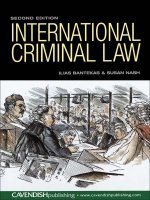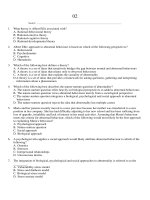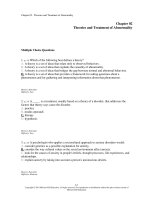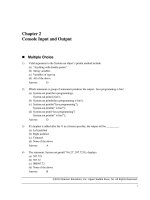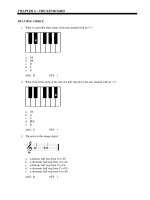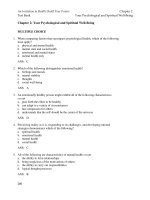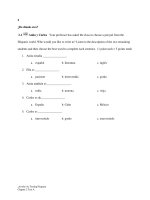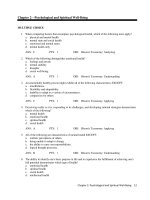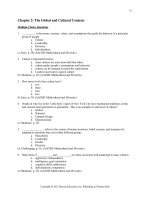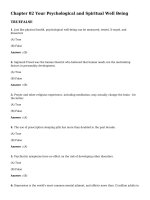Criminal law 11th edition joel samaha test bank
Bạn đang xem bản rút gọn của tài liệu. Xem và tải ngay bản đầy đủ của tài liệu tại đây (186.91 KB, 18 trang )
Instructor’s Resource Manual with Test Bank
Chapter 2 Test Bank
Constitutional Limits on Criminal Law
MULTIPLE CHOICE
1. The authors of the U.S. Constitution were suspicious of
a. the rights of individuals.
b. the rights of large groups of voters.
c. the power of influential leaders.
d. power in the hands of government officials.
ANS: D
REF: p. 41
OBJ: 1
2. What is the standard used by courts of appeal to determine if a sentence is “inside, just
outside, or significantly outside the Guidelines range?”
a. the constitutional standard
b. the abuse-of-discretion standard
c. the upward departure standard
d. the downward departure standard
ANS: B
REF: p. 88
OBJ: 7
3. According to what principle must there be a specific law defining a crime and setting
out the punishment before a person can be punished for that crime?
a. the principle of legality
b. the principle of comity
c. the principle of proportionality
d. the principle of reciprocity
ANS: A
REF: p. 42
OBJ: 2
4. What is the name of a law that criminalizes an act that was innocent when it was
committed?
a. bill of attainder law
b. forfeiture law
c. ex post facto law
d. bill of particulars
ANS: C
REF: p. 43
OBJ: 3
5. What doctrine is concerned with giving individuals fair notice of what is criminal and
preventing arbitrary or discriminatory enforcement of laws?
a. Proportionality
b. void-for-vagueness
c. Obscenity
d. equal protection
ANS: B
REF: p. 43
OBJ: 4
44
Chapter 2: Constitutional Limits on Criminal Law
6. Which amendments to the Constitution resulted in the void-for-vagueness doctrine?
a. The Fourth and Fifth Amendments
b. The Fourth and Fourteenth Amendments
c. The Fifth and Fourteenth Amendments
d. The Fifth and Fifteenth Amendments
ANS: C
REF: p. 43
OBJ: 5
7. Which Amendment to the Constitution requires that states provide equal protection of
the law?
a. The Ninth Amendment
b. The Tenth Amendment
c. The Thirteenth Amendment
d. The Fourteenth Amendment
ANS: D
REF: p. 43
OBJ: 5
8. Because sentencing guidelines are now advisory, appellate review of sentencing
decisions is limited to determining whether they are:
a. Arbitrary
b. Confused
c. Reasonable
d. Collusive
ANS: C
REF: p. 87
OBJ: 7
9. Which Amendment to the Constitution contains the Equal Protection clause?
a. The First Amendment
b. The Fourth Amendment
c. The Eighth Amendment
d. The Fourteenth Amendment
ANS: D
REF: p. 47
OBJ: 5
10. Equal protection does not require that
a. racial classifications be subjected to strict scrutiny.
b. everyone, or even all criminals, be treated exactly alike.
c. punishments be proportional.
d. classifications regarding fundamental rights be subject to strict scrutiny.
ANS: B
REF: p. 47
OBJ: 5
11. What is the level of scrutiny that most government classifications (excluding those
involving fundamental rights, race, ethnicity, religion, or gender) are subject to under
equal protection?
45
Instructor’s Resource Manual with Test Bank
a.
b.
c.
d.
heightened scrutiny
strict scrutiny
the compelling government interest test
the rational basis test
ANS: D
REF: p. 47
OBJ: 5
12. What level of scrutiny are gender classifications subject to under equal protection?
a. strict
b. heightened
c. rational basis
d. compelling interest
ANS: B
REF: p. 48
OBJ: 5
13. Which of the following rights is guaranteed by the Fourth Amendment?
a. the right to freedom from unreasonable search and seizure
b. the right to bear arms
c. the right to freedom from cruel and unusual punishment
d. the right to free speech
ANS: A
REF: p. 60
OBJ: 5
14. The U.S. Supreme Court took a “hands-off” approach to sentencing procedures until
what case?
a. Apprendi v. New Jersey (2000)
b. Blakely v. Washington (2004)
c. U.S. v. Booker (2005)
d. Gall v. U.S. (2007)
ANS: A
REF: p. 81
OBJ: 7
15. What name is given to offensive, sexually explicit material that is not protected by the
First Amendment?
a. obscenity
b. profanity
c. libel
d. literature
ANS: A
REF: p. 48
OBJ: 5
16. A trial without a jury is called:
a. a bench trial
b. a jury trial
c. a verdict trial
d. an unconstitutional trial
ANS: A
REF: p. 50
OBJ: 7
46
Chapter 2: Constitutional Limits on Criminal Law
17. The void-for-overbreadth doctrine invalidates laws that have what effect on protected
expression?
a. an unacceptable chilling effect
b. an unacceptable retracting effect
c. an unacceptable facilitating effect
d. an unacceptable excoriating effect
ANS: A
REF: p. 49
OBJ: 4
18. In Barnes v. Glen Theatre, Inc., et al. (1991), the Supreme Court ruled that a state law
banning totally nude dancing in public was
a. constitutional because it banned only totally nude dancing.
b. unconstitutional because nude dancing is expressive conduct.
c. unconstitutional because it infringes on free speech.
d. constitutional because it furthers a substantial government interest in
protecting order and morality.
ANS: D
REF: p. 52
OBJ: 4
19. Which of the following is protected by the First Amendment?
a. obscenity
b. flag burning as a political protest
c. fighting words
d. expression that creates a clear and present danger to compelling government
interests
ANS: B
REF: p. 53
OBJ: 5
20. According to Griswold v. Connecticut (1965), which of the following describes the
constitutional right to privacy?
a. a part of the liberty protected by due process
b. a fundamental right
c. required by equal protection
d. protected by the Eight and Fourteenth Amendments
ANS: B
REF: p. 59
OBJ: 5
21. In Stanley v. Georgia (1969), the Supreme Court struck down a statute which made it a
crime for an adult to possess what in their own home?
a. marijuana
b. illegal weapons
c. obscene materials
d. drug paraphernalia
ANS: C
REF: p. 63
OBJ: 5
22. Until what year did the guidelines and mandatory forms of fixed sentencing create
only possible cruel and unusual punishment problems?
a. 1990
47
Instructor’s Resource Manual with Test Bank
b. 1995
c. 2000
d. 2005
ANS: C
REF: p. 81
OBJ: 7
23. In what case did the Court apply the Apprendi rule to the U.S. Sentencing Guidelines?
a. Penry v. Lynaugh (1989)
b. U.S. v. Booker (2005)
c. Roper v. Simmons (2005)
d. Atkins v. Virginia (2002)
ANS: B
REF: p. 84
OBJ: 7
24. Which of the following kind of punishments are prohibited by the Eighth
Amendment?
a. contumacious
b. presumptuous
c. barbaric
d. sumptuous
ANS: C
REF: p. 65
OBJ: 6
25. Which Amendment contains the ban on cruel and unusual punishment?
a. The Fifth Amendment
b. The Sixth Amendment
c. The Eighth Amendment
d. The Fourteenth Amendment
ANS: C
REF: p. 65
OBJ: 6
26. In what case did the Supreme Court rule that death by electrocution did not violate the
cruel and unusual punishment clause?
a. In re Kemmler (1890)
b. Chambers v. Florida (1940)
c. Furman v. Georgia (1972)
d. Robinson v. California (1961)
ANS: A
REF: p. 65
OBJ: 5
27. The idea that the punishment must fit the crime is the Eighth Amendment principle of
a. aggregation.
b. proportionality.
c. equivocality.
d. equal protection.
ANS: B
REF: p. 66
OBJ: 6
48
Chapter 2: Constitutional Limits on Criminal Law
28. In Robinson v. California (1962), the Supreme Court ruled that a 90-day sentence for
drug addiction was
a. realistic.
b. unreasonable.
c. proportionate.
d. disproportionate.
ANS: D
REF: p. 66
OBJ: 6
29. For what crime did the Supreme Court ban the use of the death penalty in Coker v.
Georgia (1977)?
a. espionage
b. treason
c. rape of an adult female
d. murder
ANS: C
REF: p. 66
OBJ: 6
30. After U.S. v. Booker (2005) sentencing guidelines became
a. advisory.
b. mandatory.
c. unconstitutional.
d. applicable.
ANS: A
REF: p. 84
OBJ: 7
31. In which case did the Supreme Court rule that it violates the Constitution to execute a
mentally retarded criminal defendant?
a. Penry v. Lynaugh. (1989)
b. Coker v. Georgia. (1977)
c. Roper v. Simmons. (2005)
d. Atkins v. Virginia. (2002)
ANS: D
REF: p. 70
OBJ: 6
32. When U.S. Courts of Appeal review sentences, they have to consider whether a
sentence is “unreasonable” in light of the Guidelines and
a. the general purposes of sentencing under federal law.
b. the Eighth Amendment.
c. the special purposes of sentencing under federal law.
d. public opinion.
ANS: A
REF: p. 84
OBJ: 7
33. In Roper v. Simmons (2005), the Supreme Court held that the Eighth Amendment
forbids the execution of
a. rapists.
b. the mentally ill.
c. offenders who committed their crimes when they were under the age of 18.
49
Instructor’s Resource Manual with Test Bank
d. drug dealers.
ANS: C
REF: p. 72
OBJ: 6
34. What article of the U.S. Constitution bans ex post facto laws?
a. Article One
b. Article Two
c. Article Three
d. The U.S. Constitution does not ban ex post facto laws
ANS: A
REF: p. 43
OBJ: 3
35. According to the U.S. Supreme Court, California’s three-strikes law
a. does not violate the Eighth Amendment.
b. violates the Eighth Amendment.
c. is constitutional only if applied to defendants who commit very serious felonies.
d. is unconstitutional because it is disproportionate.
ANS: A
REF: p. 77
OBJ: 6
36. An ex post facto law does one of three things. Which of the following is not one of
those things?
a. punish an offender disproportionately after the crime was committed.
b. criminalize an act that was not a crime when it was committed.
c. increase the punishment for a crime after the crime was committed.
d. take away a defense after the crime was committed.
ANS: A
REF: p. 43
OBJ: 3
37. A ban on ex post facto laws seeks to accomplish two major purposes. These purposes
include which of the following?
a. protection and prevention
b. prohibition and promiscuity
c. proportion and legality
d. specificity and proportion
ANS: A
REF: p. 43
OBJ: 3
38. What two evils does the void-for-vagueness doctrine address?
a. lack of fair warning and arbitrary and discriminatory law enforcement.
b. cruel and unusual punishment.
c. retroactive and arbitrary punishment.
d. 2005
ANS: C
REF: p. 44
OBJ: 7
39. There are numerous capital crimes where no one is killed. Which of the following is
not one of those crimes?
a. rape
b. treason
50
Chapter 2: Constitutional Limits on Criminal Law
c. espionage
d. kidnapping
ANS: A
REF: p. 66
OBJ: 6
40. The American Association on Mental Retardation includes three elements in its
definition of mental retardation. Which one of the following is not one of those
elements?
a. the person has substantial intellectual impairment.
b. the impairment of the person impacts their everyday life of the mental retarded
individual.
c. retardation is present at birth or during childhood.
d. the person has an IQ below 80.
ANS: D
REF: p. 70
OBJ: 6
41. Laws that require judges to impose a nondiscretionary minimum amount of prison
time that all offenders have to serve are called
a. mandatory minimum sentencing laws
b. three strikes laws
c. capital laws
d. final sentencing laws
ANS: A
REF: p. 81
OBJ: 6
42. Most of the debate regarding three-strikes law centers on
a. deterrence
b. incapacitation
c. rehabilitation
d. none of these answers is correct
ANS: A
REF: p. 79
OBJ: 6
43. The Apprendi rule addresses
a. any fact that increases the penalty for a crime beyond the prescribed statutory
maximum.
b. any fact that decreases the penalty for a crime beyond the prescribed statutory
maximum.
c. any fact that involves the penalty for a crime beyond the prescribed statutory
maximum.
d. any fact that prioritizes the penalty for a crime beyond the prescribed statutory
maximum.
ANS: A
REF: p. 81
OBJ: 7
44. What is the name of “an appellate court’s standard for reviewing a decision that is
asserted to be grossly unsound, unreasonable, illegal, or unsupported by the
evidence?”
a. abuse-of-discretion standard.
51
Instructor’s Resource Manual with Test Bank
b. clear and present danger standard.
c. Apprendi standard.
d. void-for-vagueness standard.
ANS: A
REF: p. 87
OBJ: 7
45. What rule ensures criminality is not subject to the passions of rulers, democratic or
otherwise?
a. the rule of law
b. the rule of comity
c. the rule of Apprendi
d. the rule of censure
ANS: A
REF: p. 90
OBJ: 1
Case 2.1
Julie has been drinking at a bar for several hours. As she is driving home she runs off
the road and hits a pregnant woman, killing the fetus but not the woman. The homicide
law where Julie lives does not include the unborn in its homicide statute.
46. Julie is not convicted because to convict her would violate
a. the principle of legality.
b. the principle of fairness.
c. the principle of due process.
d. the principle of proactive lawmaking.
ANS: A
REF: p. 42
OBJ: 2
47. If Julie was convicted the court would have violated the ban on
a. ex post facto laws
b. habeas corpus laws
c. void-for-vagueness laws
d. equal protection laws
ANS: A
REF: p. 44
OBJ: 3
Case 2.2
Steve fired a gun into a Mexican family’s home in his neighborhood. Steve was later
arrested and admitted to the shooting. Following his conviction, the judge sentenced
him to 10 years in prison based on facts not determined to be true beyond a reasonable
doubt. The sentence exceeded the statutory maximum by two years.
48. The sentence imposed on Steve violates
a. the Apprendi rule.
b. the Eighth Amendment.
c. the Fourth Amendment.
d. the ban on ex-post facto laws.
ANS: A
REF: p. 81
OBJ: 7
52
Chapter 2: Constitutional Limits on Criminal Law
49. The increase in sentence by two years based on facts not determined beyond a
reasonable doubt violates what Amendment to the Constitution?
a. the Fourth Amendment.
b. the Fifth Amendment.
c. the Sixth Amendment.
d. the Eighth Amendment.
ANS: C
REF: p. 81
OBJ: 7
Case 2.3
Tammy is an unemployed probationer. Her probation officer has noted several times
that she has been seen in the company of three girlfriends at a local park. She has a
long record of convictions for various misdemeanor and felony crimes. Tammy is
sentenced to 3 years in prison based on the following statute: “Any person not engaged
in any lawful occupation, known to be a member of any gang consisting of two or
more persons, who has been convicted at least three times of being a disorderly
person, or who has been convicted of any crime, in this or in any other State, is
declared to be a gangster….”
50. Tammy’s conviction is overturned based on the
a. ex-post facto doctrine
b. void-for-vagueness doctrine
c. habeas doctrine
d. felony failure doctrine
ANS: B
REF: p. 44
OBJ: 4
51. One of the issues with Tammy’s conviction involves
a. fair warning
b. cruel punishment
c. unusual punishment
d. right privacy
ANS: A
REF: p. 44
OBJ: 4
52. Laws such as the one under which Tammy was sentenced violate what constitutional
guarantee?
a. due process
b. right to remain silent
c. freedom from unreasonable search and seizure
d. right free speech
ANS: A
REF: p. 44
OBJ: 4
Case 2.4
53
Instructor’s Resource Manual with Test Bank
Tory was fifteen years old when he intentionally pushed another high school student in
front of a car, killing him. Tory stated in court that he wanted to kill someone and
picked his victim at random. Tory has an extensive record of antisocial behavior and
was sentenced to life-without possibility of parole. Tory appealed the sentence but the
appeal was unsuccessful.
53. Tory’s appeal would most likely be based on a violation of what constitutional
amendment?
a. the Fourth Amendment.
b. the Fifth Amendment.
c. the Seventh Amendment.
d. the Eighth Amendment.
ANS: D
REF: p. 64
OBJ: 6
54. In his appeal, Tory likely argued that his sentence was
a. retroactive
b. ex post facto
c. disproportionate
d. void-for-vagueness
ANS: B
REF: p. 44
OBJ: 7
55. Tory’s failed appeal is most like what U.S. Supreme Court case?
a. State v. Ninham (2011)
b. Griswold v. Connecticut (1965)
c. Apprendi v. New Jersey (2000)
d. Gall v. U.S. (2007)
ANS: A
REF: p. 74
OBJ: 6
TRUE/FALSE
1. The constitution balances the power of government with the liberty of individuals.
ANS: TRUE
REF: p. 42
OBJ: 1
2. Ex post facto laws are forbidden by the Constitution.
ANS: TRUE
REF: p. 43
OBJ: 3
3. Retroactive criminal laws undermine the “central values” of free societies.
ANS: T
REF: p. 42
OBJ: 3
4. Racial classifications by the government are subjected to the rational basis test under
the Equal Protection Clause.
ANS: FALSE
REF: p. 47
OBJ: 5
54
Chapter 2: Constitutional Limits on Criminal Law
5. The First Amendment protects only written or spoken words.
ANS: FALSE
REF: p.48
OBJ: 1
6. Fighting words are not protected by the First Amendment.
ANS: TRUE
REF: p. 48
OBJ: 1
7. Laws that are overly broad in their reach might have a chilling effect on the exercise of
freedom of expression.
ANS: TRUE
REF: p. 50
OBJ: 4
8. The right to privacy is specifically mentioned by name in the U.S. Constitution.
ANS: FALSE
REF: p. 59
OBJ: 5
9. District of Columbia v. Heller (2008) is the first successful Second Amendment
challenge in the Court’s history.
ANS: TRUE
REF: p. 54
OBJ: 5
10. Apprendi v. New Jersey (2000) struck down a New Jersey statute authorizing judges to
increase a maximum sentence based on facts that the judge found to be true by a
preponderance of the evidence, but not proof beyond a reasonable doubt.
ANS: TRUE
REF: p. 81
OBJ: 7
11. The ban on retroactive criminal lawmaking prevents officials from punishing conduct
they think is wrong but which no existing criminal law prohibits.
ANS: TRUE
REF: p. 42
OBJ: 2
12. The Eighth Amendment requires that punishments be proportional to the crime.
ANS: TRUE
REF: p. 64
OBJ: 6
13. The death penalty is always a violation of the Eighth Amendment.
ANS: FALSE
REF: p. 64
OBJ: 5
14. Most state constitutions include a ban on retroactive statutes.
ANS: TRUE
REF: p. 43
OBJ: 3
55
Instructor’s Resource Manual with Test Bank
15. In Coker v. Georgia (1977), the Supreme Court allowed the death sentence for the
crime of rape of an adult.
ANS: FALSE
REF: p. 66
OBJ: 6
16. The Supreme Court has ruled that the death sentence is unconstitutional for the crime
of the rape of a child.
ANS: FALSE
REF: p. 67
OBJ: 6
17. Thirty-five mentally retarded persons were executed between 1976 when the death
penalty was reinstated and 2001.
ANS: TRUE
REF: p. 68
OBJ: 6
18. Until 2000, the guidelines and mandatory forms of fixed sentencing created only
possible cruel and unusual punishment problems.
ANS: TRUE
REF: p. 81
OBJ: 7
19. Three-strikes laws have been ruled unconstitutional.
ANS: FALSE
REF: p. 77
OBJ: 6
20. The U.S. Supreme Court has ruled that vague laws do not violate the guarantees of the
U.S. Constitution.
ANS: FALSE
REF: p. 43
OBJ: 4
21. Constitutional democracy is a pure democracy.
ANS: FALSE
REF: p. 42
OBJ: 1
22. In a pure democracy, the majority can have whatever it wants.
ANS: TRUE
REF: p. 42
OBJ: 1
23. The principle of legality is also called “the first principle of criminal law.”
ANS: TRUE
REF: p. 42
OBJ: 2
24. Article III of the U.S. Constitution bans ex post facto laws.
ANS: FALSE
REF: p. 43
OBJ: 3
25. Vague laws violate the Fifth and Fourteenth Amendments to the constitution.
ANS: TRUE
REF: p. 43
OBJ: 4
56
Chapter 2: Constitutional Limits on Criminal Law
26. Fair notice means that the defendant is aware that there is a law against a particular
act.
ANS: FALSE
REF: p. 44
OBJ: 4
27. Equal protection of the law requires all people to be treated exactly alike.
ANS: FALSE
REF: p. 47
OBJ: 5
28. In addition to speech, the First Amendment also includes expressive conduct.
ANS: TRUE
REF: p. 48
OBJ: 5
29. According to the U.S. Supreme Court, there are two kinds of cruel and unusual
punishments.
ANS: TRUE
REF: p. 64
OBJ: 6
30. Other than the fact of prior conviction, any fact that increases the penalty for a crime
beyond the prescribed statutory maximum must be submitted to a jury, and proved
beyond a reasonable doubt.
ANS: TRUE
REF: p. 81
OBJ: 7
COMPLETION
1. Under the Eighth Amendment, punishments must be _______________ to the offense.
ANS: proportionate
REF: p. 64
OBJ: 6
2. In a
democracy, the majority can’t make a crime out of conduct
protected by the fundamental rights in the U.S. Constitution.
ANS: constitutional
REF: p. 42
OBJ: 1
3. Because they are likely to incite violence, _______________ words are not protected
by the First Amendment.
ANS: fighting
REF: p. 48
OBJ: 1
57
Instructor’s Resource Manual with Test Bank
4. Offensive, sexually explicit material not protected by the First Amendment is called
______________.
ANS: obscenity
REF: p. 48
5.
OBJ: 5
sentencing laws require judges to impose a
nondiscretionary minimum amount of prison time that all offenders have to serve.
ANS: Mandatory minimum
REF: p. 81
OBJ: 7
6. Government classifications based on race are subject to _______________ scrutiny by
the courts.
ANS: strict
REF: p. 47
OBJ: 5
7. The Fifth Amendment to the U.S. Constitution guarantees that the federal government
shall not deny any individual life, liberty, or property without
law.
of
ANS: due process
REF: p. 47
OBJ: 4, 5
8. Under the Equal Protection Clause, most criminal statutes are subject to only the
minimal scrutiny of the _______________ basis test.
ANS: rational
REF: p. 47
OBJ: 5
9. Cruel and
punishment is prohibited by the Eighth Amendment.
ANS: unusual
REF: p. 64
OBJ: 5
10. The principle of legality establishes: “No crime without
without
.”
ANS: law, law
58
, no punishment
Chapter 2: Constitutional Limits on Criminal Law
REF: p. 42
OBJ: 2
ESSAY
1. The U.S. Supreme Court says that all racial classifications are subject to “strict
scrutiny.” What does this mean in practice? Why is racial classification held to this
high standard?
ANS: In practice, strict scrutiny means race-based classifications are never justified.
According to the U.S. Supreme Court, any statute that “invidiously classifies similarly
situated people on the basis of the immutable characteristics with which they were
born … always (emphasis added) violates the Constitution, for the simple reason that,
so far as the Constitution is concerned, people of different races are always similarly
situated.
REF: p. 47
OBJ: 6
2. What two concerns are raised by laws that are vague? Provide an example of each
concern. Why is some vagueness inevitable in any law?
ANS: The two concerns are fair notice to citizens of what is criminal and the potential
for discriminatory or arbitrary enforcement. Human language can never be perfectly
clear or cover all possible contingencies.
REF: p. 43
OBJ: 4
3. What does it mean that the First Amendment protects expressive speech? Discuss
Supreme Court cases that have dealt with expressive speech and criminal statutes.
ANS: The Constitution does not end with the spoken or written word. It includes
expressive conduct that communicates ideas and feelings. Important Supreme Court
cases about expressive speech include R.A.V. v. City of St. Paul (1992), Barnes v. Glen
Theatre, Inc. et al. (1991), and Texas v. Johnson (1989).
REF: p. 52
OBJ: 1
4. Explain how the Constitution protects our right to privacy. Discuss Griswold v.
Connecticut (1965), Stanley v. Georgia (1969), and Lawrence v. Texas (2003).
ANS: The right to privacy cannot be found in specific language in the Constitution. It
is a right that bans governmental invasions into the sanctity of one’s home. The
Supreme Court has ruled that the right to privacy emanates from six constitutional
amendments: the First (freedom of religion, speech, and association), the Third (ban
on quartering soldiers in private homes), Fourth (protection against unreasonable
searches and seizures), the Ninth (the rights enumerated in the Constitution shall not
be construed to deny other rights retained by the people), the Fifth and Fourteenth (due
process right to liberty).
59
Instructor’s Resource Manual with Test Bank
REF: p. 59; 61; 63; OBJ: 1, 5
5. Explain the principle of proportionality. Describe how the principle relates to the
death penalty and imprisonment.
ANS: The principle of proportionality has an ancient history and states that the
punishment should fit the crime. The Supreme Court has applied the principle in
several cases involving the death penalty: Coker v. Georgia (1977), Atkins v. Virginia
(2002), and Roper v. Simmons (2005). It has also recently been addressed with regard
to imprisonment in Ewing v. California (2003).
REF: p. 66
OBJ: 6
6. Explain the principle of legality. Why is it important to criminal law and punishment?
ANS: The principle of legality means that no one can be convicted of, or punished for,
a crime unless the law defined the crime and prescribed the punishment before the
person engaged in the behavior that was defined as a crime. The principle of legality is
important to criminal law and punishment because retroactive criminal laws harm
values important to a free society. Three important concepts: knowing what the law
orders makes it possible for individuals to obey the law and avoid punishment; giving
this opportunity to individual encourages human autonomy and dignity; and it
maintains the rule of law rather than the rule of officials.
REF: p. 42
OBJ: 2
7. What does an ex post facto law do? What are the two major purposes of banning ex
post facto laws?
ANS: An ex post facto law does one of three things: it criminalizes an act that was not
a crime when it was committed; increases punishment for a crime after the crime was
committed; or (3) takes away a defense that was available to a defendant when the
crime was committed. The two major purposes of banning ex post facto laws are: protecting private individuals by ensuring that legislatures give them fair warning about
what’s criminal and that they can rely on that requirement and preventing legislators
from passing arbitrary and vindictive laws.
REF: p. 43
OBJ: 3
8. Discuss the importance of the right to a trial by jury as it relates to the process of
sentencing convicted offenders. Several recent cases have impacted this right. What
are the impacts of: Apprendi v. New Jersey (2000); Blakely v. Washington (2004); and
U.S. v. Booker (2005)?
60
Chapter 2: Constitutional Limits on Criminal Law
ANS: The U.S. Supreme Court has held that an increase in the penalty for a crime beyond the statutory maximum must be based on facts submitted to a jury and proved
beyond a reasonable doubt. Apprendi struck down a New Jersey statute authorizing
judges to increase maximum sentence based on facts judge found to be true by a preponderance of the evidence, but not proof beyond a reasonable doubt and affirmed
judge’s authority to increase maximum based on prior convictions, or crimes defendants confess to, without jury finding. Blakely struck down a Washington state statute
that authorized judge to increase the length of prison time beyond the “standard range”
in the Washington sentencing guidelines based on facts not proved beyond a reasonable doubt. Booker struck down provisions in the U.S. sentencing guidelines, which allowed judges to increase individual sentences beyond the “standard range” based on
facts not proved beyond a reasonable doubt to the jury making the guidelines are advisory only.
REF: p. 81
OBJ: 7
9. Vague laws violate the due process protections of the Fifth and Fourteen Amendments
to the U.S. Constitution. Explain how these laws violate due process protections.
ANS: Vague laws violate due process protection in the following ways. The Fifth and
Fourteenth Amendments to the U.S. Constitution ban both federal and state governments from taking any person’s “life, liberty, or property without due process of law.”
Criminal punishment deprives individuals of life (capital punishment), liberty (imprisonment), or property (fines). Failure to warn private persons of what the law forbids
and/or allowing officials the chance to define arbitrarily what the law forbids denies
individuals their life, liberty, and/or property without due process of law. Vague laws
thus fail to give fair warning and allow arbitrary and discriminatory law enforcement.
REF: p. 43
OBJ: 4
10. The Eighth Amendment prohibits cruel and unusual punishment. Discuss the opinions
in the following cases regarding the courts application of the prohibition against cruel
and unusual punishment to the death penalty. Kennedy v. Louisiana (2008), Atkins v.
Virginia (2002), Roper v. Simmons (2005).
ANS: In Kennedy v. Louisiana (2008) the court held that imposing the death penalty in
the case of a child rape where death of the child did not occur and was not intended is
a violation of the Eight Amendment because it is disproportionate. The Atkins v.
Virginia (2002) case made executing anyone who proved the three elements in the
American Association on Mental Retardation definition applied to them violated the
ban on cruel and unusual punishment. In Roper v. Simmons (2005) the court held that
it is a violation of the Eighth Amendment to execute anyone who was under the age of
18 when they committed their crime.
REF: p. 64
OBJ: 6
61
